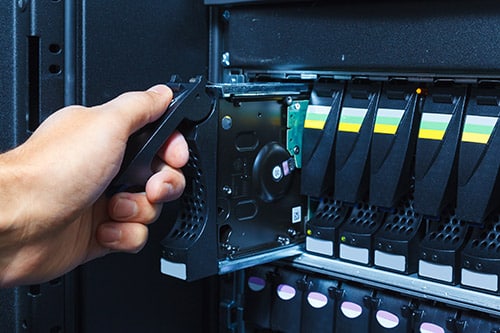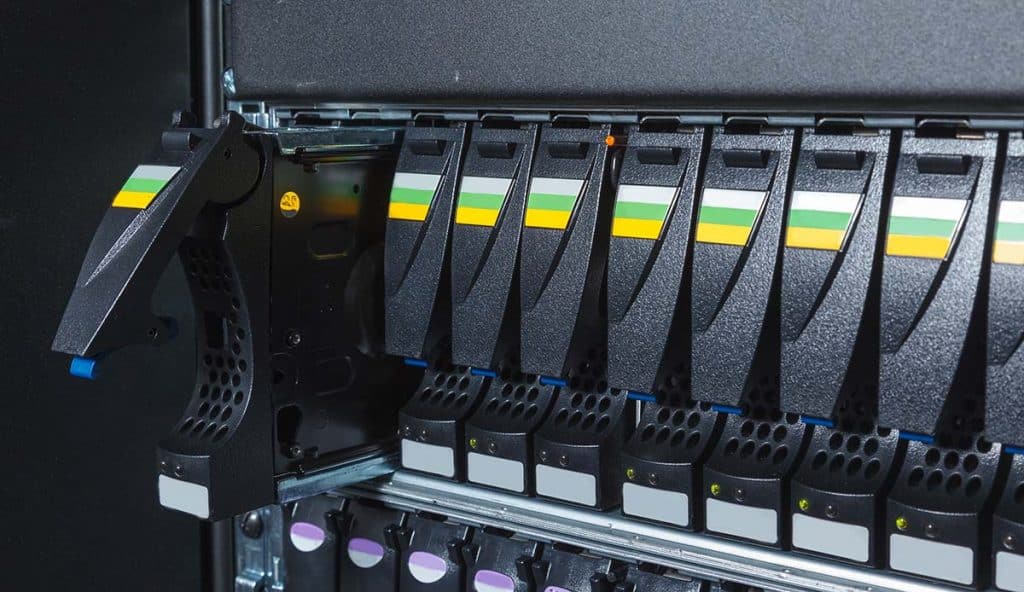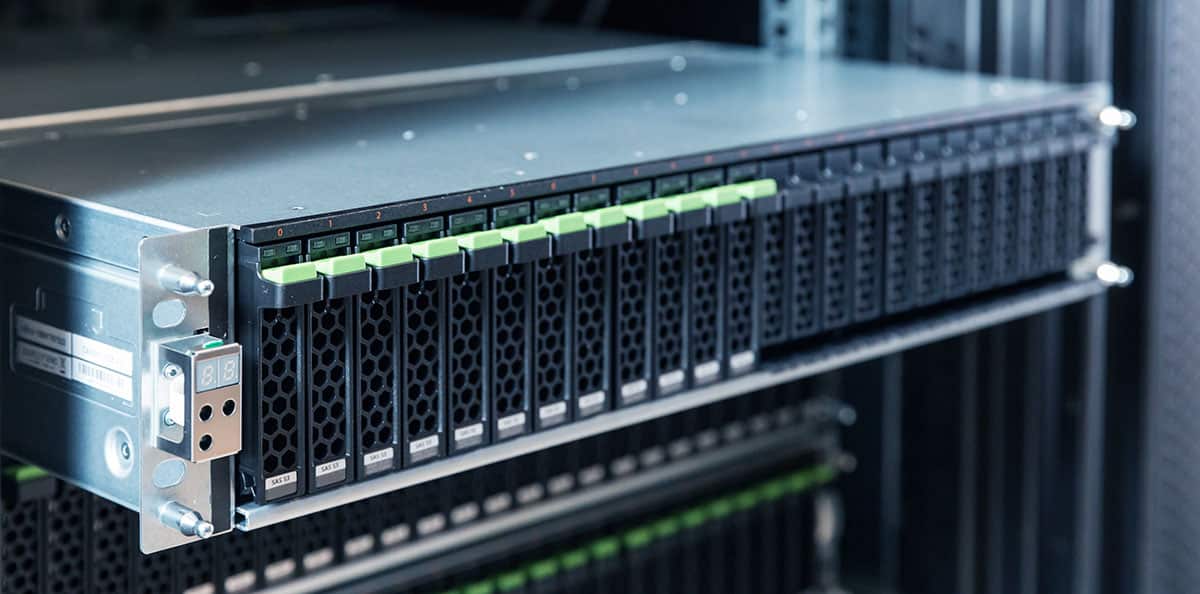You’ve come to this page because you have a failed RAID drive. You want to know what happened and if your data is recoverable. How exactly does RAID storage work, and how can it fail?
This article will outline how common RAID (Redundant Array of Independent Disks) storage configurations function and the potential failures that could occur for RAID types including RAID 0, RAID 1, RAID 5, RAID 6, and RAID 10.
At Proven Data, our RAID recovery services have successfully retrieved data from over 3,000 client cases. Our experts are ready to walk you through the RAID recovery process and return your valued data to you as efficiently as possible. Our goal is to answer your questions and provide you with the solutions you need.
By the end of this article, you will:
- Understand how common RAID configurations work
- Learn about the potential failures that can occur in each RAID configuration
- Know the next steps to take to restore your data
Common RAID storage configurations and how they work
RAID drives are designed by connecting multiple drives to expand capacity and create data redundancy. Data redundancy is the practice of storing the same data in two separate locations to create fault tolerance. If one drive fails, the other separate drive will still contain functional data. Although RAID’s multi-drive setup provides more reliability than a single drive storage system, using RAID storage does not mean you are immune to data loss. RAID failure and data loss is an issue that frequently cripples valuable data for both home users and businesses and it is important to understand that RAID is not a replacement for data backup.
Below is an overview of the five common RAID types, how they function and what makes them susceptible to failure.
How does RAID 0 work?
RAID 0 is the most basic level of RAID. Although it offers the most efficient performance of any RAID level, RAID 0’s simple two-drive configuration has the least amount of data protection and fault tolerance.
Despite its name, RAID 0 lacks data redundancy capabilities. RAID 0’s main benefit is it’s expanded capacity compared to a single drive. RAID 0’s two-drive setup gives you the advantage of speed with the capability to execute read/write operations twice as fast as a single drive.
Data is written to RAID 0 by a process called data striping. Data striping breaks your data into smaller segments and distributes it across both drives in the array. Data striping allows each drive in RAID 0 to contain a segment of the overall data.
How does RAID 0 fail?
Striping allows RAID 0 to provide its signature speedy data access but does not protect your data by making an additional copy. If one drive in RAID 0 experiences a failure, all drives in the array will also fail. One drive failure in RAID 0 results in total data loss.
Additionally, for a RAID recovery engineer to successfully recover data from RAID 0, both drives must be healthy. If one drive fails mechanically or has a logical issue, it must be fully repaired. Any corruption or damage in the array will also require RAID 0 to be repaired or rebuilt.
How does RAID 1 work?
RAID 1 is another simple RAID setup, configured using two hard drives. All data written to one of the drives is automatically mirrored, or copied, to the other drive. Duplicating every write command creates an identical pair of drives. This mirroring process enables RAID 1 to provide data redundancy.
RAID 1 can experience one drive failure without experiencing data loss. The mirroring process does decrease the write speed of RAID 1 compared to RAID 0, but all drives would have to fail to result in data loss.
How does RAID 1 fail?
Because of this mirroring, the chances of RAID 1 experiencing complete failure may seem unlikely. However, even if both RAID 1 drives don’t fail at the same time, one undetected drive failure results in your RAID 1 no longer providing data redundancy. If you don’t act immediately when one drive fails, you are risking complete data loss when the second drive fails. Additionally, both drives in RAID 1 are often manufactured at the same time, increasing the likelihood of simultaneous drive failure due to age.
How does RAID 5 work?
RAID 5 utilizes a minimum of 3 drives. RAID 5’s combination of data striping and distributed parity ensures good performance combined with more comprehensive data redundancy than lower RAID levels.
RAID 5 uses a parity drive to distribute data across multiple drives in the array without complete drive duplication. This parity drive provides one drive of data redundancy and increases performance without sacrificing much storage capacity.
RAID 5 can sustain one drive failure without experiencing data loss. The RAID controller in RAID 5 can remove one failed drive while still allowing you to access and write new data. However, if a second drive fails in RAID 5, your entire array will fail.

How does RAID 5 fail?
Since RAID 5 can remain functional after one drive failure, data loss often occurs when users continue to use RAID 5 in a degraded state. The most common RAID 5 data recovery scenario occurs as a result of multiple drives failing. RAID 5 can also fail as a result of controller failure or partition loss. The RAID controller manages and maintains all drives in the array so they work as a single unit. If the RAID controller fails, the drives in the array are often unaltered, but your data can become inaccessible. Partition loss can occur when a partition of the RAID is accidentally deleted.
How does RAID 6 work?
RAID 6 functions similarly to RAID 5 except RAID 6 uses two parity blocks per stripe. A parity block is an extra hard drive that runs integrity checks on the other drives in the array to increase fault tolerance. RAID 6’s use of two parity blocks makes it capable of handling up to two drive failures without data loss. RAID 6 does require an additional hard drive compared to RAID 5. The extra hard drive in RAID 6 does not increase capacity, but simply provides you with a second layer of parity data for added protection.
Both RAID 5 and RAID 6 are capable of replacing a failed hard drive without data loss. However, when the RAID controller rebuilds the failed drive, it creates vulnerability. The RAID controller uses a new drive to run parity checks on the other drives and subsequently turns the parity data into a duplicate of the failed drive. This process is capable of rebuilding two failed drives in RAID 6.
How does RAID 6 fail?
When the RAID controller is replacing up to two failed drives, the remaining functional drives in RAID 6 often fail due to the extra pressure put on them while the new drive is being built. Additionally, the higher the hard drive’s capacity, the longer the rebuild process takes and the more vulnerable the functioning drives become to failure.
How does RAID 10 work?
RAID 10, also known as RAID 1+0, is configured to stripe data across multiple mirrored hard drives. The combination of RAID 0 and RAID 1 features allows RAID 10 to provide data redundancy and high data transfer rates. RAID 10’s hybridization of the RAID 0 and RAID 1 configurations also increases capacity and fault tolerance similar to RAID 5 or RAID 6. However, RAID 10’s fault tolerance is dependent on which drives fail in the array.

How does RAID 10 fail?
Although RAID 10 can sustain multiple drive failures, those failures must occur in separate drive groups to avoid data loss. For example, if a drive containing original written data and a drive with the mirrored copy of that data both fail, you no longer have data redundancy and will experience data loss.
These five common RAID storage configurations can experience many different failures from a variety of causes. We’ve outlined the most common causes of failure for RAID to help you understand what happened and what RAID recovery will cost to get your data back.
How do I recover files from broken RAID storage?
There are several do’s and don’ts to RAID recovery to be aware of when your RAID has failed. The RAID recovery process, like any data recovery process, is a complicated procedure that is best left to the experts.
We recommend not removing any drives or attempting to perform a RAID recovery yourself. Here’s why: Our data recovery engineers frequently work on RAID drives that have experienced additional damage due to previous failed recovery attempts.
Do-it-yourself (DIY) data recovery is risky and failed attempts can cause irreversible damage. Attempting to recover your own data could cost you more time and money and give the professional RAID recovery engineers less chance to restore your data successfully (the first data recovery attempt is critical)!
To have the best chance of complete data recovery, reach out to a professional RAID recovery service first. This will give you the best chance of success in resolving your data loss scenario.
How much does RAID recovery cost?
Now that you understand the standard RAID configurations and potential failures, you are probably wondering how much RAID recovery will cost you. We’ve created a breakdown of the factors contributing to different RAID recovery costs to answer your questions.
No matter what RAID level you have or what failure it has experienced, the RAID recovery engineers at Proven Data are ready to assist you. We are committed to doing everything we can to find the specific RAID recovery process that will efficiently and successfully return your data to you.
To get started with RAID recovery, open a case and talk with one of our experts today!
Need help with RAID data recovery?
Learn more about our RAID storage data recovery services and how our engineers can help!
Learn more about RAID data recovery







